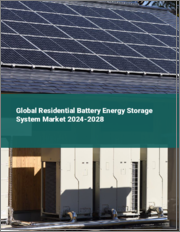
|
시장보고서
상품코드
1295321
주택용 에너지 저장 시장 - 예측(2023-2028년)Residential Energy Storage Market - Forecasts from 2023 to 2028 |
||||||
2021년 주택용 에너지 저장 시장의 시장 규모는 162억 5,700만 달러로 예측 기간 동안 19.82%의 CAGR로 성장해 2028년에는 576억 4,500만 달러에 달할 것으로 예상됩니다.
주택용 에너지 저장 시장은 주택 및 기타 주거용 건물에서 사용하도록 설계된 에너지 저장 시스템의 판매를 의미합니다. 주택용 에너지 저장 시스템은 주택 소유자에게 전기 요금이 저렴한 시간대에 태양 전지판이나 전력망과 같은 에너지 원에서 에너지를 저장할 수 있는 기능을 제공합니다. 이렇게 저장된 에너지는 피크 시간대나 정전 시 사용할 수 있습니다. 이러한 시스템에는 일반적으로 배터리, 인버터 및 주택 소유자가 에너지 소비와 생산량을 파악할 수 있는 모니터링 메커니즘이 포함됩니다. 주택용 에너지 저장 시스템은 독립적인 시스템으로 설치하거나 기존 태양광발전 시스템에 통합할 수 있습니다.
주택용 에너지 저장 시장을 주도하는 것은 정전 빈도의 증가입니다.
정전 빈도의 증가는 주택용 에너지 저장 시장의 성장을 촉진하는 중요한 요인입니다. 또한 기후변화는 허리케인, 토네이도, 눈보라, 산불과 같은 기상 현상의 빈도와 심각성에 큰 영향을 미치고 있습니다. 이러한 기상 이변은 송전선로 및 기타 인프라에 손상을 입히고 정전을 일으킬 수 있습니다. 또한 많은 국가, 특히 선진국의 전력망은 노후화되어 교체가 필요합니다. 인프라가 노후화되면 고장에 취약해져 정전으로 이어질 수 있습니다. 자연재해와 악천후는 이를 더욱 악화시켜 전기 장비와 인프라를 손상시킬 수 있습니다.
연간 정전 시간과 같은 요인도 시장에 큰 영향을 미칩니다. 정전 시간이 길어질수록 가정, 기업 및 중요한 인프라에 더 큰 혼란을 초래할 수 있으며, 이는 신뢰할 수 있는 백업 전원 솔루션의 필요성을 강조합니다. 따라서 정전 시간은 주택용 에너지 저장 시스템에 대한 수요를 좌우하는 중요한 요소입니다. 예를 들어, 호주에너지시장위원회(AEMC)는 2019년 호주에서 200건 이상의 정전이 발생하여 100만 명 이상의 고객에게 영향을 미쳤다고 보고했으며, AEMC는 이러한 정전의 주요 원인은 이상기후와 노후화된 인프라라고 지적했습니다.
시장 동향:
- 리튬이온 제조 분야의 세계 에너지 기술 기업 LG에너지솔루션은 2022년 10월 스마트홈 솔루션 기업 dcbel과 협업을 발표하며 새로운 주거용 및 가정용 에너지 저장 솔루션의 혁신을 혁신을 목표로 합니다.
- 2023년 1월, Matter Energy와 Luminous Power Technologies는 리튬 이온 배터리 기술을 기반으로 한 스마트 홈용 가정용 투자자 및 고정식 에너지 저장 솔루션을 개발하기 위해 협력한다고 발표했습니다.
- Cabot Corporation은 2022년 11월에 에너지 저장 솔루션 및 전기자동차용 리튬 이온 배터리 제조에 사용되는 전도성 탄소 첨가제 신제품 라인을 발표했습니다.
리튬이온 분야는 예측 기간 동안 강력한 성장세를 보일 것으로 예상됩니다.
리튬 이온 배터리 분야는 리튬 이온 기술의 급속한 발전과 주거용 태양광 패널 및 에너지 시스템 설치가 광범위하게 증가함에 따라 기술 유형에 따른 주택용 에너지 저장 시장 점유율의 대부분을 차지하고 있습니다. 또한, 에너지 및 배터리 저장 솔루션을 제공하는 주요 기업들의 신제품 출시와 협업 행사로 인해 리튬 이온 배터리 제조가 증가함에 따라 리튬 이온 기술 분야의 발전을 더욱 촉진하고 있습니다.
주택 부문에서 리튬 이온 배터리가 선호되는 이유는 태양광발전 설치 용량이 증가하고 있기 때문입니다. 리튬 이온 배터리 기술은 에너지 저장 및 방출을 효과적이고 신속하게 모니터링하여 가정의 변동하는 에너지 수요를 충족시킬 수 있습니다. 또한 이 배터리는 방전 깊이가 깊고 배터리 왕복 효율이 높기 때문에 재생 가능한 태양 에너지 시스템에서 생산된 잉여 에너지를 저장할 수 있습니다. 따라서 전 세계적으로 태양광 패널과 태양광발전 시스템의 설치가 증가하고 있으며, 이는 예측 기간 동안 리튬 이온 배터리 기술 시장이 확대될 수 있는 기회를 제공하고 있습니다.
2021년 주택용 에너지 저장 세계 시장에서 북미 지역이 큰 비중을 차지했습니다.
지역별로 주택용 에너지 저장 시장은 북미, 남미, 유럽, 중동 및 아프리카, 아시아태평양으로 나뉩니다.
미국 내 에너지 저장 산업은 최근 몇 년 동안 괄목할 만한 성장을 이루었고, 앞으로도 계속 급성장할 것으로 예상됩니다. 이에 따라 주택용 에너지 저장 시스템 제조업체들은 현재 여러 가지 기회를 맞이하고 있습니다. 이 시장을 주도하는 것은 탄력성을 높이고자 하는 소비자의 욕구, 순 계량 정책의 수정, 주택용 에너지 저장 시스템 도입에 대한 금전적 인센티브 등입니다. 미국 내 주택용 에너지 저장 산업은 최근 몇 년 동안 급속한 성장세를 보이고 있으며, 설치량은 에너지 용량 기준으로 2017년 29MWh에서 2020년 540MWh로 증가했습니다. 설치량은 전력 용량 기준으로 2017년 13MW에서 2020년 235MW로 증가했습니다. 설치량은 2020년 4분기에 90MW로 크게 증가하여 2021년 1분기에는 100MW를 넘어섰습니다. 캘리포니아는 2020년 설치량의 57%를 차지했고, 하와이는 16%로 두 번째로 큰 시장이었습니다. 또한 미국 소비자들은 에너지 저장과 태양광발전 시스템의 결합에 관심을 보이고 있으며, USITC의 데이터에 따르면, 설치 건수에서 공동주택의 에너지 저장이 태양광발전 설비의 20%를 차지했으며, 2017년에는 7%를 차지했습니다.
목차
제1장 서론
- 시장 개요
- 시장의 정의
- 조사 범위
- 시장 세분화
- 통화
- 가정
- 기준 연도와 예측 연도 타임라인
제2장 조사 방법
- 조사 데이터
- 가정
제3장 주요 요약
- 조사 하이라이트
제4장 시장 역학
- 시장 성장 촉진요인
- 시장 성장 억제요인
- Porter's Five Forces 분석
- 업계 밸류체인 분석
제5장 주택용 에너지 저장 시장 : 전원 유형별
- 서론
- 3-6kW
- 6-10kW
제6장 주택용 에너지 저장 시장 : 테크놀러지 종류별
- 서론
- 리튬이온
- 납축
- 플로우
- 염화 니켈 나트륨
제7장 주택용 에너지 저장 시장 : 접속 유형별
- 서론
- 온그리드
- 오프그리드
제8장 주택용 에너지 저장 시장 : 지역별
- 서론
- 북미
- 미국
- 캐나다
- 멕시코
- 남미
- 브라질
- 아르헨티나
- 기타
- 유럽
- 독일
- 프랑스
- 영국
- 스페인
- 이탈리아
- 기타
- 중동 및 아프리카
- 사우디아라비아
- 이스라엘
- 아랍에미리트
- 기타
- 아시아태평양
- 중국
- 일본
- 한국
- 인도
- 인도네시아
- 대만
- 태국
- 기타
제9장 경쟁 환경과 분석
- 주요 기업과 전략 분석
- 신흥 기업과 시장 수익성
- 기업 인수합병(M&A), 합의, 협업
- 벤더 경쟁력 매트릭스
제10장 기업 개요
- Tesla
- BYD Motors Inc.
- Trojan Battery Company, LLC
- Saft
- Enphase Energy
- Magellan Power
- LG Energy Solution
- Huawei Technologies Co., Ltd.
- Samsung SDI Co., Ltd.
- SMA Solar Technology AG
The residential energy storage market was valued at US$16.257 billion in 2021 and is expected to grow at a CAGR of 19.82% over the forecast period to be worth US$57.645 billion by 2028.
The residential energy storage market refers to the sales of energy storage systems designed for use in homes and other residential buildings. Residential energy storage systems offer homeowners the ability to store energy from sources like solar panels and the grid during times when electricity is less expensive. This stored energy can then be used during peak usage or when there is a power outage. Such systems typically involve batteries, inverters, and monitoring mechanisms that enable homeowners to keep track of their energy consumption and production. Residential energy storage systems can be installed as independent systems or integrated into existing solar PV systems.
The residential energy storage market is driven by the increasing frequency of power outages.
The increasing frequency of power outages is a significant driver for the growth of the residential energy storage market. In addition, climate change is having a substantial impact on the frequency and severity of weather events such as hurricanes, tornadoes, snowstorms, and wildfires. These extreme weather conditions can cause damage to power lines and other infrastructure, leading to power outages. Furthermore, the electrical grid in many countries, particularly in developed countries, is aging and needs upgrades. As infrastructure ages, it becomes more susceptible to failures, which can result in power outages. Natural disasters and severe weather events can exacerbate this, which can damage electrical equipment and infrastructure.
Factors such as the annual duration of electric power interruptions also significantly affect the market. Longer power interruptions can lead to more significant disruptions to households, businesses, and critical infrastructure, highlighting the need for reliable backup power solutions. Therefore, the duration of power interruptions is an essential factor influencing the demand for residential energy storage systems. For example, the Australian Energy Market Commission (AEMC) reported over 200 power outages in Australia in 2019, affecting over 1 million customers. The AEMC noted that extreme weather conditions and aging infrastructure were the primary causes of these outages.
Market Developments:
- LG Energy Solution, an international energy technology company involved in lithium-ion manufacturing, announced its collaboration with dcbel, an energy company promoting smart home solutions, in October 2022 to innovate new residential and home energy storage solutions.
- Matter Energy and Luminous Power Technologies, two residential energy solution provision companies, announced their collaboration in January 2023 to create home investors and stationary energy storage solutions for smart homes based on lithium-ion battery technology.
- Cabot Corporation introduced a new product line of conductive carbon additives in November 2022 to be used in manufacturing lithium-ion batteries for energy storage solutions and electric vehicles.
The lithium-ion segment will witness robust growth over the forecast period.
The lithium-ion battery sector holds a significant portion of the residential energy storage market share based on the type of technology due to the rapid advancement in lithium-ion technology and the widespread growth in the installation of solar panels and energy systems in the residential sector. In addition, the increase in the manufacture of lithium-ion batteries fueled by new product launches and collaboration events initiated by leading companies providing energy and battery storage solutions is further stimulating the development of the lithium-ion technology segment.
The increasing preference for lithium-ion batteries in the residential sector can be attributed to the rise in installed solar capacity. Lithium-ion battery technology can meet the fluctuating energy demands of households by effectively and rapidly monitoring energy storage and release. In addition, these batteries can store the excess energy produced by renewable solar energy systems due to their higher depth of discharge and battery round-trip efficiency. Therefore, the rise in the installation of solar panel and photovoltaic systems across the world provide an opportunity for the expansion of the lithium-ion battery technology market over the forecast period.
North America accounted for a major share of the global residential energy storage market in 2021.
The residential energy storage market has been segmented by geography into North America, South America, Europe, the Middle East and Africa, and the Asia Pacific.
The domestic energy storage industry in the United States has experienced a remarkable expansion in recent years and is projected to continue growing quickly. As a result, manufacturers of residential energy storage systems now have several opportunities. The market is being driven by consumers' desire to become more resilient, modifications to net metering policies, and the financial incentives of installing a residential energy storage system. The domestic residential energy storage industry in the United States has shown rapid expansion in recent years, with installations rising from 29 MWh in 2017 to 540 MWh in 2020, measured by energy capacity. Installations rose in terms of electricity capacity from 13 MW in 2017 to 235 MW in 2020. Installations significantly increased to 90 MW in the fourth quarter of 2020 and rose to above 100 MW in the first quarter of 2021. California accounted for 57 percent of installations in 2020, while Hawaii was the second-largest market with 16 percent of the total installation. In addition, consumers in the United States are becoming more interested in combining energy storage with solar PV systems. According to USITC data, in terms of installations, energy storage in residential complexes made up 20 percent of solar PV installations in 2020 compared to 7 percent in 2017.
Market Segmentation:
BY POWER TYPE
- 3-6 kW
- 6-10 kW
BY TECHNOLOGY TYPE
- Lithium-Ion
- Lead Acid
- Flow
- Sodium Nickel Chloride
BY Connectivity Type
- On-Grid
- Off-Grid
BY GEOGRAPHY
- North America
- USA
- Canada
- Mexico
- South America
- Brazil
- Argentina
- Others
- Europe
- Germany
- France
- United Kingdom
- Spain
- Italy
- Others
- Middle East and Africa
- Saudi Arabia
- Israel
- UAE
- Others
- Asia Pacific
- China
- Japan
- South Korea
- India
- Indonesia
- Taiwan
- Thailand
- Others
TABLE OF CONTENTS
1. INTRODUCTION
- 1.1. Market Overview
- 1.2. Market Definition
- 1.3. Scope of the Study
- 1.4. Market Segmentation
- 1.5. Currency
- 1.6. Assumptions
- 1.7. Base, and Forecast Years Timeline
2. RESEARCH METHODOLOGY
- 2.1. Research Data
- 2.2. Assumptions
3. EXECUTIVE SUMMARY
- 3.1. Research Highlights
4. MARKET DYNAMICS
- 4.1. Market Drivers
- 4.2. Market Restraints
- 4.3. Porter's Five Force Analysis
- 4.3.1. Bargaining Power of Suppliers
- 4.3.2. Bargaining Power of Buyers
- 4.3.3. Threat of New Entrants
- 4.3.4. Threat of Substitutes
- 4.3.5. Competitive Rivalry in the Industry
- 4.4. Industry Value Chain Analysis
5. RESIDENTIAL ENERGY STORAGE MARKET ANALYSIS, BY POWER TYPE
- 5.1. Introduction
- 5.2. 3-6 kW
- 5.3. 6-10 kW
6. RESIDENTIAL ENERGY STORAGE MARKET ANALYSIS, BY TECHNOLOGY TYPE
- 6.1. Introduction
- 6.2. Lithium-Ion
- 6.3. Lead Acid
- 6.4. Flow
- 6.5. Sodium Nickel Chloride
7. RESIDENTIAL ENERGY STORAGE MARKET ANALYSIS, BY CONNECTIVITY TYPE
- 7.1. Introduction
- 7.2. On-Grid
- 7.3. Off-Grid
8. RESIDENTIAL ENERGY STORAGE MARKET ANALYSIS, BY GEOGRAPHY
- 8.1. Introduction
- 8.2. North America
- 8.2.1. USA
- 8.2.2. Canada
- 8.2.3. Mexico
- 8.3. South America
- 8.3.1. Brazil
- 8.3.2. Argentina
- 8.3.3. Others
- 8.4. Europe
- 8.4.1. Germany
- 8.4.2. France
- 8.4.3. United Kingdom
- 8.4.4. Spain
- 8.4.5. Italy
- 8.4.6. Others
- 8.5. Middle East and Africa
- 8.5.1. Saudi Arabia
- 8.5.2. Israel
- 8.5.3. UAE
- 8.5.4. Others
- 8.6. Asia Pacific
- 8.6.1. China
- 8.6.2. Japan
- 8.6.3. South Korea
- 8.6.4. India
- 8.6.5. Indonesia
- 8.6.6. Taiwan
- 8.6.7. Thailand
- 8.6.8. Others
9. COMPETITIVE ENVIRONMENT AND ANALYSIS
- 9.1. Major Players and Strategy Analysis
- 9.2. Emerging Players and Market Lucrativeness
- 9.3. Mergers, Acquisition, Agreements, and Collaborations
- 9.4. Vendor Competitiveness Matrix
10. COMPANY PROFILES
- 10.1. Tesla
- 10.2. BYD Motors Inc.
- 10.3. Trojan Battery Company, LLC
- 10.4. Saft
- 10.5. Enphase Energy
- 10.6. Magellan Power
- 10.7. LG Energy Solution
- 10.8. Huawei Technologies Co., Ltd.
- 10.9. Samsung SDI Co., Ltd.
- 10.10. SMA Solar Technology AG



















